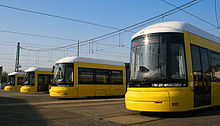Tram transport in Berlin

|
||||||||||||||||||||||||||
| Operation | ||||||||||||||||||||||||||
|---|---|---|---|---|---|---|---|---|---|---|---|---|---|---|---|---|---|---|---|---|---|---|---|---|---|---|
| Locale | Berlin, Germany | |||||||||||||||||||||||||
|
||||||||||||||||||||||||||
|
||||||||||||||||||||||||||
The Berlin tramway (German: Straßenbahn Berlin) is the main tram system in Berlin, Germany. It is one of the oldest tram networks in the world having its origins in 1865 and is operated by Berliner Verkehrsbetriebe (BVG), which was founded in 1929. It is notable for being the third largest tram system in the world, after Melbourne and St. Petersburg. Berlin's streetcar system is made up of 22 lines that operate across a standard gauge network, with almost 800 stops and measuring almost 190 kilometres (120 mi) in route length and 430 kilometres (270 mi) in line length. Nine of the lines, called Metrotram, are operated 24 hours per day, and are identified with the letter 'M' before their number; the other thirteen lines are regular city tram lines and are identified by just a line number.
Most of the recent network is within the confines of the former East Berlin—tram lines within West Berlin having been replaced by buses during the division of Berlin (the first extension into West Berlin opened in 1994 on today's M13). In the eastern vicinity of the city there are also three private tram lines not part of the main system, whilst to the south-west of Berlin is the Potsdam tram system with its own network of lines.
In 1865, a horse tramway was established in Berlin. In 1881, the world's second electric tram line opened. Numerous private and municipal operating companies constructed new routes, so by the end of the 19th century the network developed quite rapidly, and the horse trams were changed into electric ones. By 1930, the network had a route length of over 630 km (391 mi) with more than 90 lines. In 1929, all operating companies were unified into the BVG. After World War II, BVG was divided into an eastern and a western company but was once again reunited in 1992, after the fall of East Germany. In West Berlin, by 1967 the last tram lines had been shut down. With the exception of two lines constructed after German reunification, the Berlin tram continues to be limited to the eastern portion of Berlin.
...
Wikipedia

